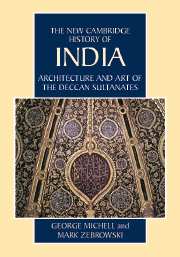Book contents
- Frontmatter
- Introduction
- 1 Historical framework
- 2 Forts and palaces
- 3 Mosques and tombs
- 4 Architectural decoration
- 5 Miniature painting: Ahmadnagar and Bijapur
- 6 Miniature painting: Golconda and other centres
- 7 Textiles, metalwork and stone objects
- 8 Temples
- 9 Conclusion
- Appendix: Dynastic Lists of Deccan Rulers
- Bibliographic Essay
- Bibliography
- Index
- Map of the Southern Deccan"
- Plate Section"
Introduction
Published online by Cambridge University Press: 28 March 2008
- Frontmatter
- Introduction
- 1 Historical framework
- 2 Forts and palaces
- 3 Mosques and tombs
- 4 Architectural decoration
- 5 Miniature painting: Ahmadnagar and Bijapur
- 6 Miniature painting: Golconda and other centres
- 7 Textiles, metalwork and stone objects
- 8 Temples
- 9 Conclusion
- Appendix: Dynastic Lists of Deccan Rulers
- Bibliographic Essay
- Bibliography
- Index
- Map of the Southern Deccan"
- Plate Section"
Summary
The plateau region in the centre of peninsular India, known as the Deccan, is one of the country’s most mysterious and unknown regions in terms of artistic heritage. Few scholars, Indian or foreign, have worked extensively in the Deccan, which remains little visited and surprisingly unexplored. In consequence, many sites of outstanding historical and architectural significance, whether urban mosques and tombs or remote mountain citadels, lack adequate documentation and publication. A further problem is that in the past relatively few works of art were given a Deccani attribution. An increasing number of miniature paintings, textiles and inlaid metal objects are now assigned to this region. This means that the time has come for a reassessment of the Deccan as a dynamic centre of patronage for architecture and the fine arts.
Before considering individual monuments and works of art, it is important to stress the remarkably high quality of Deccani architecture and art. Courtly and religious buildings, miniature paintings, textiles and metal objects from this region are among the finest the subcontinent. And much of Deccani art is rare, far rarer than Mughal art. It is likely that the painting workshops in the Deccan were always smaller than those of North India. Rarity increases the risk of oblivion and makes research and publishing all the more urgent. Furthermore, the emotional content of Deccani art is unique. Whereas Mughal art has a generous dose of logic and verisimilitude behind its glamour, especially in its classic phase under the patronage of Jahangir, Shah Jahan and Aurangzeb in the seventeenth century, Deccani art revels in dream and fantasy.
- Type
- Chapter
- Information
- Architecture and Art of the Deccan Sultanates , pp. 1 - 3Publisher: Cambridge University PressPrint publication year: 1999



